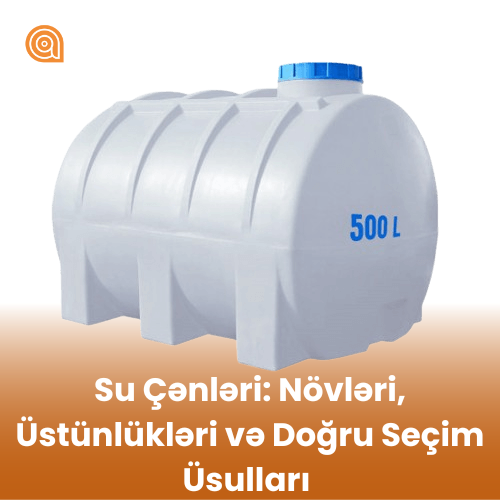Main Functions of Water Tanks
- Water Storage – Used for storing drinking and technical water for long periods.
- Water Supply – Serves as a backup water source during shortages or low pressure situations.
- Water Pressure Regulation – Helps maintain stable pressure within water systems.
- Rainwater Collection – Used for collecting and utilizing rainwater to conserve water.
- Industrial and Agricultural Use – Plays a role in industrial processes and irrigation for agriculture.
Main Types of Water Tanks
- Plastic Water Tanks – Lightweight, rust-resistant, and available in various sizes.
- Metal Water Tanks – Made of stainless steel or galvanized material, durable and long-lasting.
- Concrete Water Tanks – Used for large volumes of water storage, durable and stable.
- Fiberglass Water Tanks – High durability, resistant to chemicals.
- Underground Water Tanks – Installed below ground, space-saving and aesthetically beneficial.
- Mobile Water Tanks – Portable tanks intended for temporary use.
Advantages of Water Tanks
Water tanks are an ideal solution for water storage and backup. Their main advantages include:
✅ Continuous Water Supply – A water tank can be used as a backup during water cuts, ensuring uninterrupted supply.
✅ Economic Efficiency – Helps conserve water by collecting rainwater or water from other sources.
✅ Eco-friendly – Collecting and reusing rainwater prevents water wastage.
✅ Variety of Material Options – Water tanks are available in various materials such as plastic, metal, and concrete, offering choices to meet specific needs.
✅ Variety of Sizes and Designs – Available in different sizes and models for homes, gardens, industries, and agriculture.
✅ Water Quality Protection – High-quality water tanks prevent contamination and keep water clean for long periods.
✅ Easy Installation and Maintenance – Modern water tanks are easy to install and require minimal maintenance.
When choosing a water tank, it is important to consider its size, material, and suitability for the intended use. This will ensure both convenience and long-term savings. 💧
Proper Installation and Use of Water Tanks
Installation Guidelines
✅ Proper Location – The tank should be placed on a flat, stable, and firm surface to prevent movement or damage.
✅ Stable Base Preparation – A concrete platform or sturdy metal supports should be placed under the tank to prevent tilting or sinking over time.
✅ Protection from Sunlight – The tank should be protected from direct sunlight or made of UV-resistant material to preserve water quality and prevent algae growth.
✅ Proper Pipe Connections – The inlet and outlet pipes should be of high quality and securely connected to prevent leaks.
Proper Use and Maintenance
✅ Regular Cleaning – The tank should be cleaned periodically, and any sediment buildup should be removed. This should be done every 6 months.
✅ Use of Filtration Systems – It is advisable to use filtration systems to prevent contamination of incoming water.
✅ Ensure Air Circulation – The tank’s lid should be tightly sealed, but small ventilation holes should allow for air circulation.
✅ Avoid Overfilling – Overfilling the tank can cause damage to its structure.
✅ Winter Preparation – During cold weather, insulation measures should be taken to prevent the tank from freezing. Insulation materials are recommended for tanks exposed to outdoor conditions.
Proper installation and maintenance will help preserve the water quality, extend the tank's lifespan, and ensure a continuous water supply. 💧
Frequently Asked Questions about Water Tanks
What types of water tanks are available?
Water tanks are made from various materials, including:
- Plastic Water Tanks – Lightweight and rust-resistant.
- Metal Water Tanks – Durable and long-lasting.
- Concrete Water Tanks – Suitable for underground storage.
- Fiberglass Water Tanks – Resistant to chemicals.
Where is the best place to install a water tank?
Water tanks can be installed outdoors, underground, or indoors. The location should be chosen based on the intended use of the water and the local climate.
How should a water tank be cleaned?
The tank should be cleaned every 6 months. Steps include:
- Emptying the tank.
- Scrubbing the interior surfaces with a brush and clean water.
- Using disinfectant solutions for sanitation.
How can water quality be maintained in a water tank?
- Keep the lid closed to prevent dust and insects from entering.
- Use filters and screens.
- Protect from sunlight to prevent algae growth.
What should be done to prevent the tank from freezing in winter?
- Add insulation materials to the tank.
- Cover the tank's bottom part with soil.
- Ensure there is circulating water movement.
How long can a water tank be used?
The lifespan of a water tank depends on its material:
- Plastic Tanks – 10-20 years.
- Metal Tanks – 20-30 years (with anti-rust coating).
- Concrete Tanks – Over 30 years.

